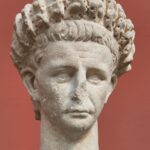The National Prado Museum in Madrid has a wonderful Roman marble sculpture in collection, which received the name “Apotheosis of Claudius”. In the upper part of the sculpture is beautifully shaped eagle, which is on the pile of weapons. The eagle holds lightning in one claw and an orb in the other.
The composition is on a rectangular grave pedestal, on the urn that has gone missing (probably containing the remains of Korwinus). The object was built during the reign of Octavian Augustus (27 BCE – 14 CE). The sculpture has the inscription: IMPERATOR·CAESAR·DIVI·FILIVS·AVGVSTVS, meaning “Emperor Caesar Augustus, son of the deified [Julius Caesar]”.
The object was found in the village villa of Marcus Valerius Messalla Corvinus (64 BCE – 13 CE), Roman commander, politician, patron of the arts, comrade of Augustus.
Where does the name of the sculpture come from? In about 1650, at the behest of cardinal Girolamo Colonna, for unknown reasons the Italian sculptor – Orfeo Boselli – added a bust of Emperor Claudius on the wings of an eagle. This was to symbolize the deification of Claudius, who was raised to the gods by the victorious eagle. Interestingly, the bust was lost, and the name remained.







